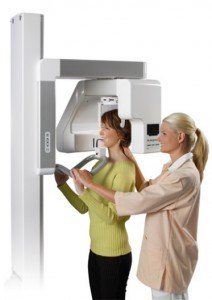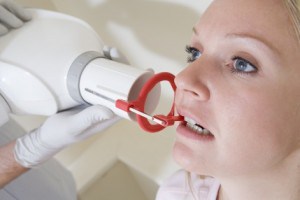It is generally recommended that children and adults visit their general dentist twice a year for routine check-ups and cleanings. As a part of these visits, x-rays are often required annually for the identification and diagnosis of dental conditions. And, while I believe that the benefits of x-rays far outweigh the risks, concern about the amount of radiation from dental x-rays remains one the most common questions in dentistry.

Panoramic x-ray
The most prescribed dental x-rays are:
- Bite-wing x-rays which focus on the upper and lower back teeth and check for decay between teeth,
- Periapical x-rays which show the entire length of a tooth from crown to root and is used to look at the health of the bone that supports the teeth and to detect abscesses, cysts, tumors and impacted teeth,
-

Bite-wing x-ray
Occlusal x-rays which show nearly the full arch of teeth in either the upper or lower jaw. These x-rays are used to detect extra teeth, teeth that have not yet broken through, jaw fractures, cleft palate, unusual growths or foreign objects,
- Panoramic x-rays which are a two-dimensional tomographic exam that show the entire mouth in a single image including teeth, jaws, and surrounding tissue,
- Cone beam CT (computed topography) Scan which is a three-dimensional image of the teeth, soft tissues, nerve pathways and bone in a single scan. Commonly used by oral surgeons and orthodontists, the images from a cone beam CT allow for better treatment planning and placement of dental implants.
So, how much radiation are you exposed to during an x-ray?
Radiation is measured in sieverts which indicates the health effect of low levels of ionizing radiation on the human body. Since a Sievert is a very large dose, most measurements are done in millisieverts.
| Image | Amount of radiation in millisieverts (mSv) |
| Bite-wing (2) x-ray | .004 mSv |
| Periapical (2)x-ray | .004 mSv |
| Panoramic x-ray | .007 mSv |
| Cone Beam scan for oral surgery/ortho | .009 mSv |
| CT scan of head | 2.00 xSv |
| X-ray of an extremity | .001 mSv |
| CT scan of chest | 8.00 mSv |
| Mammogram (two dimensional) | .700 mSv |
A large amount of radiation can cause tissue damage and increase the risk of developing cancer later in life. The average American is exposed to 3mSv of naturally occurring radiation during the course of a year. This naturally occurring radiation, or background radiation, originates from radioactive materials in the environment, radon gas in homes and cosmic rays from outer space.
While x-rays, radiography, contribute to the overall radiation exposure for a patient, it is well-documented that the amount of radiation exposure for dental x-rays is very small compared to other radiography. It is always best to weigh the benefits and risks of any medical or dental procedure, but x-rays are an invaluable tool for your dentist or specialist when diagnosing dental conditions. Together with your practitioner’s best professional judgement, you can decide whether or not an x-ray or computed tomography (CT) is right for you.
Dr. M. James Clark is a board-certified oral surgeon at Northwest Oral & Maxillofacial Surgery. For more information about Dr. Clark and his colleagues, please visit texasoralsurgery.com. Dr. Clark is located at 4185 Technology Forest in The Woodlands and can be reached at 281-367-2001.
